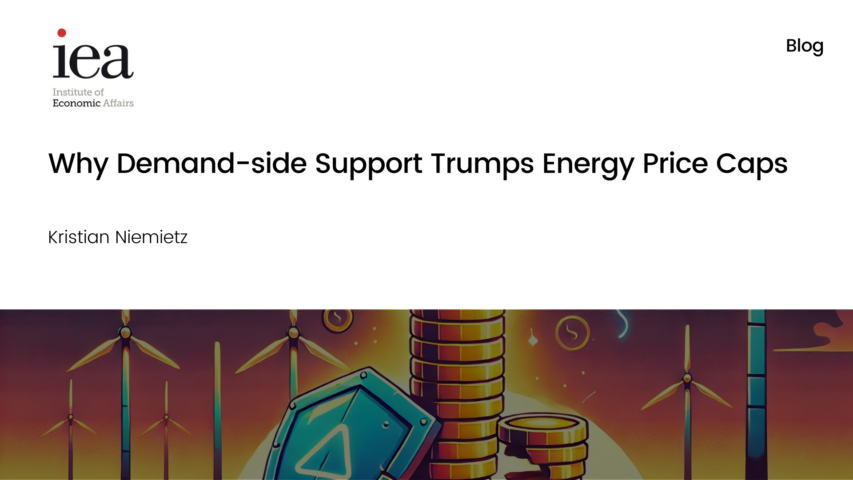Why Demand-side Support Trumps Energy Price Caps

Why Demand-side Support Trumps Energy Price Caps
Kristian Niemietz // 14 September 2022
Imagine you buy 10 cans of beer every week, at a price of €2.50 each.
Due to a shortage of hops, the price of a can of beer now soars to €5 per can. This means that if you carried on drinking 10 cans of beer per week, your total beer budget would have to rise from €25 to €50.
Now, suppose the government decides to compensate you for the beer price hike. They ponder two different policy options to do this:
- Cap the price of beer at the old price of €2.50 per can, and pay a subsidy of €2.50 per can – the difference between the market price and the capped price – to the brewery, to compensate the brewery for the increased price of hops. If you carry on buying 10 cans, this policy would cost the government £25 per week.
- Allow the price to rise to €5, and pay you a lump sum compensation of €25.
Both policies would cost the same, and both could lead to identical outcomes. But even in this über-simplified example, they probably would not.
Option 1 simulates a situation in which nothing has changed. To you, it looks as though beer continues to cost £2.50 a can, just as it always has. Unless you read about it in the news, you might never even know that there is a hop crisis going on.
Option 2 takes away the pain of the beer price hike (because it fully compensates you for it), but it still makes you notice that it has happened. You are still faced with very different relative prices. Suppose a can of cider costs €2.50, and a bottle of wine €7.50. This means that the opportunity cost of every can of beer has risen steeply, and no amount of compensation can take that away. Before the price hike, each can of beer meant giving up one can of cider, or one third of a bottle of wine. Now, it means giving up two cans of cider, or two thirds of a bottle of wine. You can carry on buying 10 cans of beer, if that’s what you want. The compensation payment enables you to do that. But it can’t take away that nagging feeling of guilt about what you could have had instead.
So unless you have a religious commitment to your current level of beer consumption, under option 2, you would probably make some adjustments. And that is desirable. Because, remember, the price of beer has not gone up because brewers have suddenly become greedier. It is because of a hop shortage, which will sooner or later manifest itself in fewer beer cans on the shelves. If you have already adjusted your consumption, you may not notice that. But if you arrive one day, expecting your 10 cans, and there are only 5 cans on the shelf – you have a problem.
If the price of X goes up, we buy less X. This happens for two reasons, which economists call the “income effect” and the “substitution effect”. A price hike makes us poorer: it is as if we had taken a pay cut. And if we are poorer, we generally buy less stuff, across the board – not specifically less X, but including less X.
But an increase in the price of X also makes it more lucrative to substitute Y and/or Z for X, because we now get more Y and more Z for every unit of X we give up. That is the substitution effect.
In the above example, both policy options eliminate the income effect of the price change. You are not poorer than you were before. But option 1 also eliminates the substitution effect, while option 2 leaves it intact.
Option 2 is therefore clearly the superior strategy, even in this ultra-simple example. The case for option 2 becomes stronger if we look at the effect on an entire population, rather than just a single individual. It is not necessary for everyone to be sensitive to beer price changes. But if we look at a sufficiently large population, someone will be. What matters is the aggregate effect.
More importantly, with option 2, support can be targeted, i.e. focused on those who need it most. Option 1 indiscriminately subsidises everyone’s consumption, whether you are a single mum who works as a cleaner, or whether you are Roman Abramovich.
This can be true under option 2 as well. If that compensation payment is a universal benefit, Roman Abramovich would receive it too. But under option 2, this is a political choice. The government can means-test the payment, and target it in whichever way it wants to (provided it has the administrative capacity). They can choose to limit it to the bottom third of the income distribution, or the bottom quarter, or the bottom quintile, or the bottom decile.
Under option 1, you cannot do that, unless you want the shopkeeper to ask each customer: “Sorry, are you Roman Abramovich, by any chance? Because if so, I need to charge you the uncapped market price. However, if you are a cleaner, I will charge you the capped price, and claim back the difference from the government.”
You have, of course, figured out that this article is not really about beer (or even wine or cider), but energy. Governments all over Europe have responded to the energy price surge with a package of measures. Some of these are a variant of option 1 (suppressing price signals and compensating energy companies), and some are a variant of option 2 (direct financial support to households). But there has been a strong bias towards price suppression-type measures. As the International Monetary Fund explains:
“[M]any European governments have taken measures to delay the pass-through of wholesale to retail energy prices through tax reductions or price controls. […] [T]hese measures are an inefficient tool to protect the economically vulnerable, are fiscally costly, and they mute the demand adjustment to the price shock (including energy-conserving behavior and energy efficiency investments).”
Switching to option-2-type measures would be vastly more cost-effective:
“Policy responses to the surge in energy costs should aim to preserve the price signal while providing targeted support. For households, lump-sum cash transfers, vouchers, or fixed discounts on utility bills are appropriate means of providing income support without distorting marginal energy prices, thus conserving the incentive to reduce energy consumption. As an example, fiscal measures to fully offset the consumption losses of the bottom 20 (40) percent of households would have an average annual estimated cost of 0.4 (0.9) percent of GDP in European economies. Non-targeted measures typically have a larger fiscal cost […]
In some countries, the fiscal costs of measures introduced since the summer of 2021 are estimated to exceed 1.5 percent of GDP by end-2022. Most of these costs come from non-targeted relief measures such as cuts in VAT/excise taxes or price caps”
Unfortunately, the UK government’s strategy is also heavily biased towards option-1-type measures. The exact cost is, as yet, unknown, but as my colleague Andy Mayer shows, even if you take a conservative estimate, it would have been more than enough to pay for an extremely generous package of direct support for households and businesses.
This would have offered more bang for the buck, and much stronger incentives to economise on energy.
The original article was published on the IEA’s blog.
EPICENTER publications and contributions from our member think tanks are designed to promote the discussion of economic issues and the role of markets in solving economic and social problems. As with all EPICENTER publications, the views expressed here are those of the author and not EPICENTER or its member think tanks (which have no corporate view).



